Vitrectomy procedures effective in diabetic maculopathy
The presence of subfoveal hard exudates, however, may be the cause of poor visual acuity results and may require submacular surgery.
TAORMINA, Italy — Vitrectomy with posterior vitreous detachment is effective in reducing macular edema and improving visual acuity in diabetic maculopathy, according to Fumitaka Ando, MD, head of the Nagoya National Hospital Eye Clinic, Japan.
At the Jules Gonin Club meeting here, Dr. Ando presented the results of 109 eyes of 70 patients treated with vitrectomy between August 1994 and September 1998. Included in the study were 40 men and 30 women between the ages of 20 and 77 years. Preoperatively, they presented with diffuse macular edema without posterior vitreous detachment and no posterior vitreous membrane. Follow-up ranged between 3 and 49 months.
Visual acuity improvements
“We collected our first results in February 1999. Visual acuity improved by more than two lines in 62 eyes (56.9%), remained unchanged in 30 eyes (27.5%) and deteriorated in 17 eyes (15.6%). The proportion of patients who improved their vision was statistically significant (P<0.01),” Dr. Ando said.
In approximately 75% of cases, Dr. Ando reported, the macular edema diminished or disappeared. In these patients, optical coherence tomography (OCT) visualized the recovery of the fovea to almost normal shape.
No statistically significant difference was found between patients who underwent or did not undergo grid pattern macular photocoagulation before vitrectomy.
“This factor seems to have no influence on the outcome of vitreous surgery and on the improvement of postoperative vision,” Dr. Ando said. Functional results of the same cases were re-examined 1 year later.
“In some cases, visual acuity had improved even further. We counted a total of 65 eyes (59.6%) that had improved and 32 eyes (29.4%) that had remained stable. The number of eyes reporting visual loss had reduced to 12 (11.0%),” Dr. Ando said.
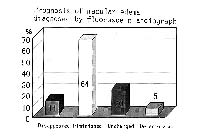 Prognosis of macular edema diagnosed by fluorescein angiograph. | 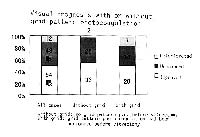 Visual prognosis with or without grid pattern photocoagulation. No statistically significant difference was found between patients with or without grid pattern macular photocoagulation before vitrectomy. |
Submacular deposits hinder results
Deterioration of vision was due to a number of different causes. Postoperative corneal ulcer, aggravation of the macular edema, neovascular glaucoma, scarring of the grid pattern, macular atrophy and nuclear cataract were responsible for one case each. The remaining six cases were due to accumulation of submacular hard exudates.
“Submacular deposits of hard exudates are the main cause of visual loss and should be considered a severe complication,” Dr. Ando said.
“We deal with it by performing submacular surgery before vitrectomy,” he continued.
Results of this procedure have been reported in Japan since 1998. Dr. Ando applied it to 17 cases of diabetic maculopathy with subfoveal deposits of hard exudates.
“Preoperative vision was 0.1 or less in all cases. After surgery, we examined our patients at 6-month intervals and noticed a slow but sure improvement in most cases. Between 6 and 18 months, visual acuity had improved by two lines in seven eyes (41.2%), had remained stable in eight eyes (47.1%) and had deteriorated in two (11.8%). At a later stage of the follow-up, around 24 months, nine (52.9%) eyes had improved visual acuity, six eyes (35.3%) were stable and the same two eyes were the same as they were previously,” he said.
Interestingly, most of the eyes that showed a tendency toward poor improvement or deterioration of vision had a history of vitrectomy for diabetic maculopathy.
“Vitrectomy carried out before submacular surgery may have negative effects on the results of the operation,” Dr. Ando said. “Of the nine eyes in which visual acuity improved, seven had no previous history of vitrectomy, and the two eyes that had lost some lines of visual acuity had had vitrectomy before submacular surgery.”
The size of hard exudate deposits also seemed to be related to the results of submacular surgery. There were significantly fewer cases of improved vision in patients with large deposits of more than 1.0 DD compared to patients with deposits of less than 0.5 DD.
 Optical Coherent Tomograph (OCT) with macular edema. |  OCT after vitrectomy of the same case shown in preceding figure. |
Examples
Examples of fundus photographs and OCT maps were shown by Dr. Ando to illustrate different outcomes of posterior vitrectomy in diabetic maculopathy.
The first two examples showed large deposits of hard exudates and an atrophic-looking postoperative fovea. Visual acuity did not improve postoperatively.
Preoperative and postoperative OCT maps gave very clear evidence of the improvement of one eye, where vision had recovered from preop 0.06 to postop 0.1.
Another case improved from preoperative 0.02 to postoperative 0.5. OCT maps of the same case showed the modifications obtained with surgery in comparison with the preoperative situation.
In conclusion, according to Dr. Ando, “vitrectomy is an effective procedure in diabetic diffuse macular edema if the hard exudates are washed out during submacular surgery.”
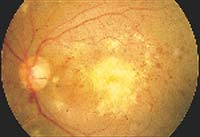
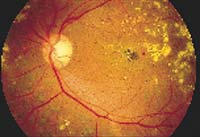
Pre-vitrectomy fundus photograph (left). Post-operatively, hard exudates disappeared from the fovea (right).
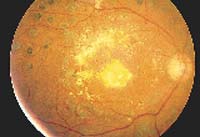

Pre-operative fundus photograph (left). Hard exudates disappeared post-operatively (right). However, the fovea area where hard exudates deposited looks atrophic.


Pre-vitrectomy OCT (left). Post-operative, normal OCT (right).

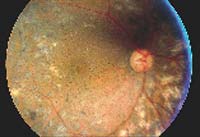
Pre-operative fundus photograph (left). Visual acuity was poor despite the small size of the deposit. The same patient (right) showed disappearance of the hard exudates and a dried-up appearance of the macular retina.
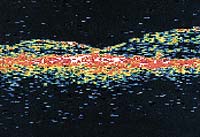

Pre-operative OCT (left). Post-operative OCT shows normal shape (right).
For Your Information:
- Fumitaka Ando, MD, is medical director of ophthalmology at Nagoya National Hospital, Japan. He can be reached at the Department of Ophthalmology, Nagoya National Hospital, 4-1-1 San-no-maru, Naka-ku, Nagoya 460-0001, Japan; 81 052 951 1111; fax: 81 052 951 0664.
